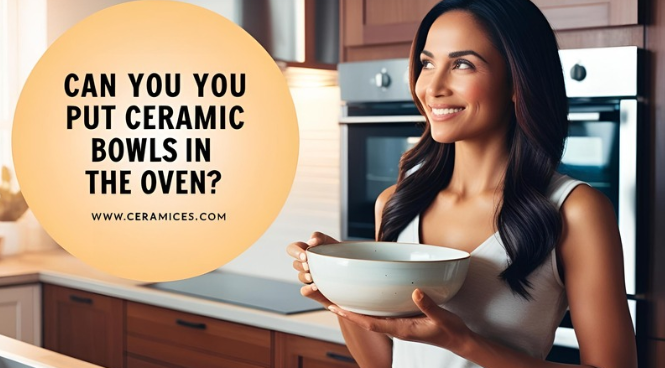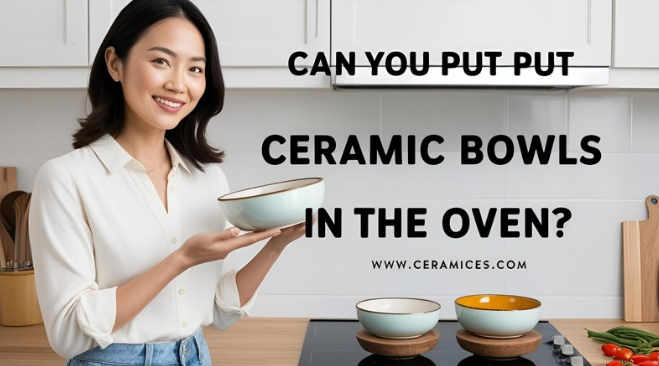Ceramic bowls are a kitchen staple, prized for their versatility, durability, and aesthetic appeal. Whether you’re using them for mixing, serving, or baking, ceramic bowls are a reliable choice. However, one common question that arises is, “Can you put ceramic bowls in the oven?” The answer depends on the type of ceramic and how it’s manufactured. In this comprehensive guide, we’ll explore everything you need to know about using ceramic bowls in the oven, including the types of ceramic that are oven-safe, temperature limits, and tips for safe baking. We’ll also answer 10 frequently asked questions to help you confidently use ceramic bowls in your cooking and baking endeavors.
Understanding Ceramic Bowls: Composition and Properties
Before using ceramic bowls in the oven, it’s essential to understand what ceramic is made of and how it behaves under heat. Ceramic is a non-metallic, inorganic material typically made from clay that is fired at high temperatures. This process makes ceramic hard and durable, but its heat resistance can vary depending on the type of clay and glaze used.
Key Characteristics of Ceramic Bowls:
- Heat Resistance: Most ceramic bowls are designed to withstand high temperatures, making them suitable for oven use.
- Porosity: Unglazed ceramic is porous, while glazed ceramic has a protective layer that makes it non-porous and easier to clean.
- Durability: Ceramic is sturdy but can be brittle and prone to cracking under sudden temperature changes.
Can You Put Ceramic Bowls in the Oven? The Answer Explained

The short answer is yes, you can put ceramic bowls in the oven, but with some important caveats. Not all ceramic bowls are created equal, and their ability to withstand oven temperatures depends on their quality, glaze, and construction.
Factors to Consider Before Using Ceramic Bowls in the Oven:
- Quality of the Ceramic: High-quality ceramic bowls are more likely to handle oven temperatures without cracking or breaking.
- Glaze: Glazed ceramic bowls are generally safer for oven use because the glaze provides an additional layer of protection.
- Temperature Limits: Most ceramic bowls are oven-safe up to a certain temperature, typically around 350°F to 500°F (175°C to 260°C).
How to Safely Use Ceramic Bowls in the Oven:
- Check the Manufacturer’s Instructions: Always refer to the care instructions provided by the manufacturer to ensure the bowl is oven-safe.
- Avoid Thermal Shock: Gradually heat the ceramic bowl by placing it in a cold oven and allowing it to heat up with the oven.
- Use Oven Mitts: Ceramic bowls can become very hot in the oven, so always use oven mitts when handling them.
Benefits of Using Ceramic Bowls in the Oven
Using ceramic bowls in the oven offers several advantages:
- Even Heat Distribution: Ceramic heats evenly, which is ideal for baking casseroles, bread, and desserts.
- Non-Reactive Material: Ceramic does not react with acidic or alkaline foods, preserving the flavor and quality of your dishes.
- Aesthetic Appeal: Ceramic bowls are visually appealing, making them perfect for serving directly from the oven to the table.
Risks of Using Ceramic Bowls in the Oven
While ceramic bowls are generally safe for oven use, there are some risks to be aware of:
- Cracking or Breaking: Poor-quality ceramic or sudden temperature changes can cause the bowl to crack.
- Glaze Damage: Repeated exposure to high temperatures can damage the glaze, leading to discoloration or chipping.
- Safety Concerns: A cracked or damaged ceramic bowl can pose safety risks, especially if it breaks during use.
How to Choose Oven-Safe Ceramic Bowls

Selecting the right ceramic bowls for oven use is crucial for safety and functionality. Here are some tips:
- Check for Oven-Safe Labels: Look for labels or markings indicating that the bowl is oven-safe.
- Inspect for Damage: Avoid using bowls with cracks or chips, as they are more likely to break in the oven.
- Consider the Size: Ensure the bowl is the right size for your oven and the dish you’re preparing.
Tips for Using Ceramic Bowls in the Oven
To ensure a successful baking experience, follow these tips:
- Preheat the Oven: Always preheat the oven before placing the ceramic bowl inside.
- Avoid Extreme Temperature Changes: Do not place a cold ceramic bowl directly into a hot oven or vice versa.
- Use a Baking Sheet: Placing the ceramic bowl on a baking sheet can help distribute heat evenly and prevent spills.
FAQs About Using Ceramic Bowls in the Oven
1. Can all ceramic bowls go in the oven?
Not all ceramic bowls are oven-safe. Always check the manufacturer’s instructions before using a ceramic bowl in the oven.
2. What temperature can ceramic bowls withstand?
Most ceramic bowls are oven-safe up to 350°F to 500°F (175°C to 260°C), but this can vary depending on the manufacturer.
3. Can I use a ceramic bowl in a convection oven?
Yes, ceramic bowls can be used in convection ovens, but be mindful of the temperature and cooking time.
4. Can I put a ceramic bowl in the microwave?
Most microwave-safe ceramic bowls can also be used in the oven, but always check the manufacturer’s guidelines.
5. What happens if I use a non-oven-safe ceramic bowl in the oven?
Using a non-oven-safe ceramic bowl in the oven can cause it to crack, break, or even shatter.
6. Can I use a ceramic bowl on the stovetop?
Most ceramic bowls are not designed for direct stovetop use. However, some ceramic cookware is specifically made for stovetop cooking.
7. How do I know if my ceramic bowl is oven-safe?
Look for labels or markings indicating that the bowl is oven-safe. If unsure, contact the manufacturer for clarification.
8. Can I put a cold ceramic bowl in a hot oven?
No, sudden temperature changes can cause the bowl to crack. Always allow the bowl to adjust to room temperature before placing it in the oven.
9. Can I use a ceramic bowl for baking bread?
Yes, ceramic bowls are excellent for baking bread, as they provide even heat distribution.
10. How do I clean a ceramic bowl after baking?
Allow the bowl to cool completely before washing it with warm, soapy water. Avoid using abrasive cleaners that can damage the glaze.
Conclusion
So, can you put ceramic bowls in the oven? The answer is yes, but it requires careful consideration of the bowl’s quality, glaze, and temperature limits. By following the tips and guidelines outlined in this article, you can safely use ceramic bowls for baking and cooking, ensuring delicious results and a beautiful presentation.
Whether you’re baking a casserole, roasting vegetables, or serving a hearty stew, ceramic bowls offer a versatile and aesthetically pleasing option for your kitchen. Just remember to handle them with care, and they’ll serve you well for years to come. If you’re ever in doubt, opt for alternative cookware to ensure your safety and the longevity of your kitchen tools.
By following the insights and advice provided in this article, you’ll be well-equipped to make the most of your ceramic bowls in the oven. Happy cooking!
Read more contents
1 KitchenAid Ceramic Bowl: Which one is for you?